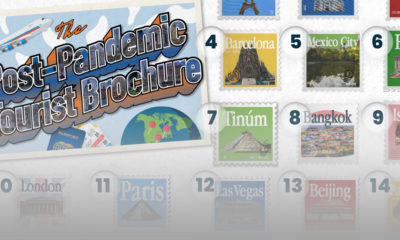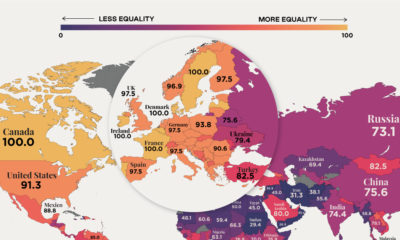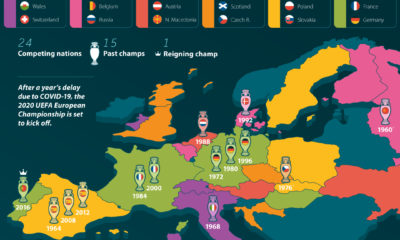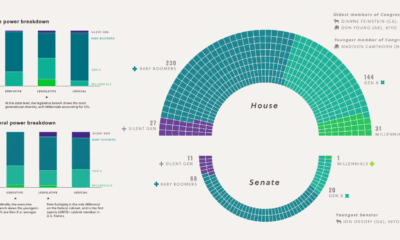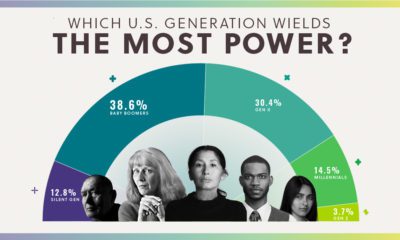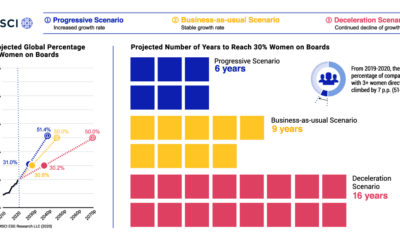From the right to vote, to owning property and assets, women’s legal and economic rights have come a long way. International Women’s Day, held annually on March 8th is an opportunity to commemorate global improvements around gender equality. One big driver for this is women’s political participation—however, progress in this area has not been distributed evenly worldwide.
Women’s Political Power: Share of Ministers in Cabinets
In this map, we dig into how much political power women hold around the world. The Council on Foreign Relations pulls the latest data from UN Women and the Inter-Parliamentary Union (IPU) to examine the shares of women holding ministerial positions in 195 national cabinets. Here are the top five countries with the highest percentages of women’s political power:
🇪🇸 Spain: 66.7% 🇫🇮 Finland: 61.1% 🇳🇮 Nicaragua: 58.8% 🇨🇴 Colombia: 57.9% 🇦🇹 Austria: 57.1%
Even though women make up half the global population, they’re not always represented at higher levels of government. Only 14 countries have at least 50% women holding ministerial positions in the national cabinet. On the flip side, nine countries have 0% women in their national cabinet, such as Saudi Arabia and Thailand. The silver lining to this is that Saudi Arabia is actually improving in some areas of women’s economic rights in recent years, such as granting more freedom of movement to travel and prohibiting employment discrimination on the basis on gender.
The Most Powerful Women: Female Heads of State/Government
From Indira Gandhi to Margaret Thatcher, many women have held notable and influential leadership positions in the past, serving as tours de force for the global economy. Presently, there are only 24 countries with a female head of state or government. Moldova’s Maia Sandu is the latest to rise into a Presidential role as of December 2020. Here’s who the rest are, and their titles. Last updated: Mar 2, 2021 As the chancellor of Germany, Angela Merkel holds the longest consecutive term of all female heads of state/government. With 15 years under her belt, Merkel is largely seen as a de facto leader of Europe. However, she intends to step down as chancellor after her term ends in September 2021. Since 1946, Switzerland has had five total elected or appointed female heads of state or governments—the highest of any country. Simonette Sommaruga, the most recent female president of the nation, was only succeeded in the new year and dropped off this list.
Glass Ceiling in Politics?
While women have made strides in reaching their political potential worldwide, it’s interesting to note that they generally have a harder time ascending to office in larger countries compared to smaller economies. For example, Estonia is the first country to have two female heads of state/government with both the president and prime minister positions being filled by women. On the flipside, many other countries have never had even one female head of state. That said, shares of women holding seats in national legislatures are growing worldwide, which means that progress in these upper levels may be just around the corner. on Even while political regimes across these countries have changed over time, they’ve largely followed a few different types of governance. Today, every country can ultimately be classified into just nine broad forms of government systems. This map by Truman Du uses information from Wikipedia to map the government systems that rule the world today.
Countries By Type of Government
It’s important to note that this map charts government systems according to each country’s legal framework. Many countries have constitutions stating their de jure or legally recognized system of government, but their de facto or realized form of governance may be quite different. Here is a list of the stated government system of UN member states and observers as of January 2023: Let’s take a closer look at some of these systems.
Monarchies
Brought back into the spotlight after the death of Queen Elizabeth II of England in September 2022, this form of government has a single ruler. They carry titles from king and queen to sultan or emperor, and their government systems can be further divided into three modern types: constitutional, semi-constitutional, and absolute. A constitutional monarchy sees the monarch act as head of state within the parameters of a constitution, giving them little to no real power. For example, King Charles III is the head of 15 Commonwealth nations including Canada and Australia. However, each has their own head of government. On the other hand, a semi-constitutional monarchy lets the monarch or ruling royal family retain substantial political powers, as is the case in Jordan and Morocco. However, their monarchs still rule the country according to a democratic constitution and in concert with other institutions. Finally, an absolute monarchy is most like the monarchies of old, where the ruler has full power over governance, with modern examples including Saudi Arabia and Vatican City.
Republics
Unlike monarchies, the people hold the power in a republic government system, directly electing representatives to form government. Again, there are multiple types of modern republic governments: presidential, semi-presidential, and parliamentary. The presidential republic could be considered a direct progression from monarchies. This system has a strong and independent chief executive with extensive powers when it comes to domestic affairs and foreign policy. An example of this is the United States, where the President is both the head of state and the head of government. In a semi-presidential republic, the president is the head of state and has some executive powers that are independent of the legislature. However, the prime minister (or chancellor or equivalent title) is the head of government, responsible to the legislature along with the cabinet. Russia is a classic example of this type of government. The last type of republic system is parliamentary. In this system, the president is a figurehead, while the head of government holds real power and is validated by and accountable to the parliament. This type of system can be seen in Germany, Italy, and India and is akin to constitutional monarchies. It’s also important to point out that some parliamentary republic systems operate slightly differently. For example in South Africa, the president is both the head of state and government, but is elected directly by the legislature. This leaves them (and their ministries) potentially subject to parliamentary confidence.
One-Party State
Many of the systems above involve multiple political parties vying to rule and govern their respective countries. In a one-party state, also called a single-party state or single-party system, only one political party has the right to form government. All other political parties are either outlawed or only allowed limited participation in elections. In this system, a country’s head of state and head of government can be executive or ceremonial but political power is constitutionally linked to a single political movement. China is the most well-known example of this government system, with the General Secretary of the Communist Party of China ruling as the de facto leader since 1989.
Provisional
The final form of government is a provisional government formed as an interim or transitional government. In this system, an emergency governmental body is created to manage political transitions after the collapse of a government, or when a new state is formed. Often these evolve into fully constitutionalized systems, but sometimes they hold power for longer than expected. Some examples of countries that are considered provisional include Libya, Burkina Faso, and Chad.
